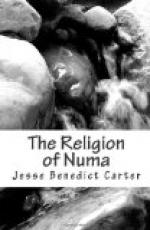It was necessary to go into these details in order that we might understand as much as possible of the process by which the gods of the Sibylline books were assimilated into the body of Roman religion. We see how in the main they were superfluous and therefore unnecessary and even undesirable because by their presence they robbed old Roman deities of their existence, and how those elements in them which were least in accord with the old Roman spirit were most apt to develop, and how in general their adoption was a purely mechanical process, like any act in witchcraft, where the form is all important because the meaning cannot be understood, and how totally different therefore the estate of these gods was in Rome from what it had been in Greece, because in Rome they were introduced, stripped of all their mythology, worshipped only for their practical bearings, and compelled therefore to work for their living.
The importation of grain from Cumae meant more to Rome than the mere satisfaction of her physical needs; it meant much more than the addition of three deities to her state-cult, for the grain thus imported was carried from Cumae to Ostia by sea and so up the Tiber to Rome, and the whole matter therefore marks one of the important steps in Rome’s interest in commerce generally but especially in ocean commerce. As yet she did not do the actual carrying herself, but she began to be interested in it, and the sea began to mean something to this inland town. This increased interest in trade in general and this inceptive interest in those who “go down to the sea in ships” have both of them left their reflexion in the religious life of the time; two new deities are introduced, both of them almost certainly by means of the Sibylline oracles, though some accidental blanks in our historical tradition have deprived us of details.




